|
|
|
Sort Order |
|
|
|
Items / Page
|
|
|
|
|
|
|
| Srl | Item |
| 1 |
ID:
105132


|
|
|
|
|
| Publication |
2011.
|
| Summary/Abstract |
Agricultural machinery involves use of equipment and machines that are required to perform various crop production activities. The use of agricultural machinery leads to better utilization of inputs and improvement in agricultural operations, particularly in large scale crop production. Most of the earlier innovations in India in this sector were on tractors and drillers. There has been an increase in the innovations in machinery in the pre-harvest as well as post-harvest operations. The present study attempts to analyse patenting activity to identify current innovations on agricultural machinery in India. Analysis of published applications revealed that the area of irrigation and post-harvest processing had the maximum filing. In the case of granted patents, majority of the patents belong to the area of plant growth and post-harvest operations. The analysis reveals the specific patent portfolios and the scope of future innovations in the agriculture engineering sector.
|
|
|
|
|
|
|
|
|
|
|
|
|
|
|
|
| 2 |
ID:
105128
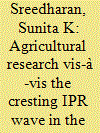

|
|
|
|
|
| Publication |
2011.
|
| Summary/Abstract |
Innovative resource use or 'jugaad' by ordinary Indian has contributed immensely to adapting to hardships on the one hand and adding to the global knowledge bank on the other hand. In the present era, India possesses one of the more elegant IPR systems in the world, although the newly enacted laws have encountered minor hiccups. In fact, it was an Indian agricultural product (Basmati rice) that caused a furore over three continents on three different aspects of intellectual property laws in the last decade of the 20th century. However, the 21st century seeks answers to problems beyond the major milestones in Indian agriculture (the green and white revolutions) to tackle the problems of food security and volatile food prices. The gap in the perception of researchers and legal acumen needs to be bridged; wherein IP audit is an important tool to assess and project the intellectual properties of clients. This paper attempts to synthesize a well-knit idea for IPR awareness in agriculture sector using sectoral as well as external examples.
|
|
|
|
|
|
|
|
|
|
|
|
|
|
|
|
| 3 |
ID:
105121


|
|
|
|
|
| Publication |
2011.
|
| Summary/Abstract |
This paper assimilates and contributes to the current state of IPR knowledge and proprietary products in the Indian jurisdiction. The influence of international IPR domain and influx of proprietary foreign technology products on Indian agricultural technology profile vis-à-vis the plight of the national players is discussed, particularly, with respect to patenting in plant biotechnology/transgenics. The factual scenario under the national PPV&FR regime is narrated. This paper also analyses the recent foreign interests in respect of patenting in the areas of animal vaccines and diagnostics vis-à-vis the existing strength of the national system, which needs to be maintained.
|
|
|
|
|
|
|
|
|
|
|
|
|
|
|
|
| 4 |
ID:
105135
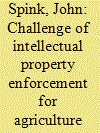

|
|
|
|
|
| Publication |
2011.
|
| Summary/Abstract |
One often-overlooked aspect of intellectual property rights (IPR) strategy is the deterrence and enforcement against 'irresponsible defendants' including product counterfeiters. When applied to food, the consumer product fraud or product counterfeiting is referred to as food fraud, or economically motivated adulteration. While this problem is not unique to agriculture and food products, there are special circumstances and issues to consider. The objectives of this paper are to: (1) review the underlying fraud opportunities (complex and on a massive scale), including an exploration of types of fraudsters and types of fraud (near infinite); (2) review how globalization and source economies contribute to the problem; (3) review the complexity and challenges of enforcement for companies and agencies; and (4) introduce the 'chemistry of the crime' or the 'crime triangle', to shift the focus from reactionary intervention and response to proactive prevention. Five applicable case studies are included, bringing insights on the irresponsible nature of many of the fraudsters. Through its review of fraudsters and types of fraud, this study will provide information to assist with IP technology transfers and the effective enforcement of IPR. Product counterfeiting often poses a very serious public health and economic threat to agriculture and food products. There are very motivated, intelligent, resilient and aggressive fraudsters, but they can be deterred by companies or agencies focused on reducing fraud opportunities. Standard business practices-even identified best practices-often inadvertently contribute to fraud opportunities.
|
|
|
|
|
|
|
|
|
|
|
|
|
|
|
|
| 5 |
ID:
105137
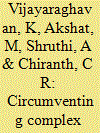

|
|
|
|
|
| Publication |
2011.
|
| Summary/Abstract |
Licensing of technologies by companies and research institutes is a recent phenomenon that has gained immense popularity in the agricultural sector, it being imperative for the research fraternity to gain access to validated technologies, enhance their product portfolio, and accelerate access to commercialization ensuring outreach of good science to farmers. Two case studies pertaining to rice and chickpea are discussed in the paper to elucidate this process.
|
|
|
|
|
|
|
|
|
|
|
|
|
|
|
|
| 6 |
ID:
105133
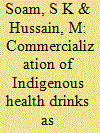

|
|
|
|
|
| Publication |
2011.
|
| Summary/Abstract |
A survey under United Nations Conference on Trade and Development project in 25 states of India identified promising indigenous drinks that merit protection as Geographical Indications (GI) including 'nannari' from Andhra Pradesh, 'kokum' from Western Ghats and 'burransh' from Uttarakhand. These are obtained from roots of Hemidesmus indicus, fruits of Garcinia indica and flowers of Rhododendron arboretum, respectively. Manufacturing procedures involving application of community traditional knowledge, and ethno-medicine properties are scientifically documented. Product acceptability by the retailers and consumers is high; hence companies would be willing to invest in such products. Here, one of the important issues to be addressed is benefit sharing with traditional knowledge holders and alleviation of their socio-economic condition. Producers are unorganized and dispersed with seasonal employment and are not known outside restricted area. Therefore, can GI be a platform for product and market development addressing socio-economic issues? The products have a sufficient niche market since per capita fruit juice consumption in India is only 20 ml. Market demand is expected to increase from 27.4 to 64 billion rupees by 2020 with 8.9 per cent market growth, with 65 per cent market share restricted to South India. In such a scenario, can registered GIs accelerate the growth through market penetration? The study offers solutions/models for GI registration and business strategy with sustainable rural livelihood development.
|
|
|
|
|
|
|
|
|
|
|
|
|
|
|
|
| 7 |
ID:
105122


|
|
|
|
|
| Publication |
2011.
|
| Summary/Abstract |
The UPOV Convention was adopted in 1961, and it entered into force in 1968. The Convention aims at encouraging innovation in the field of plant breeding. It provides a legal framework and system of implementation of plant variety protection and is the only internationally harmonized, effective sui generis system of plant variety protection. The UPOV Convention was amended in 1972, 1978 and 1991. UPOV had 68 members as on 4 November 2010, and the numbers continue to expand. The impact study carried out by an ad hoc working group, and published by UPOV has shown the benefits of an effective sui generis system of plant variety protection.
|
|
|
|
|
|
|
|
|
|
|
|
|
|
|
|
| 8 |
ID:
105134
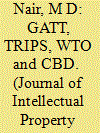

|
|
|
|
|
| Publication |
2011.
|
| Summary/Abstract |
From the current perspective on 'IPR and Agriculture', there has to be a major discussion on global developments, negotiations and agreements on the role of intellectual property protection on the future of the agricultural sector, a vital segment for ensuring food security for the world population, particularly for developing countries where assuring food security is essential for their survival. Modern day intellectual property protection systems have their genesis in the General Agreement on Tariffs and Trade (GATT) which was initiated in 1946. Currently, the provisions under several agreements are being implemented by the Members of the World Trade Organization (WTO), the sole administrative body responsible for all aspects of implementation, monitoring and resolution of disputes between the member countries. Apart from the separate Agreement on Agriculture (AOA) which formed part of GATT, other agreements particularly Trade-Related Aspects of Intellectual Property Rights (TRIPS) also impinge heavily on the future of agriculture across the world. It is therefore prudent to evaluate the role that GATT, TRIPS, WTO, CBD and climate change play in the sustenance and development of agriculture pursuits, primarily in the developing and least developed economies.
|
|
|
|
|
|
|
|
|
|
|
|
|
|
|
|
| 9 |
ID:
105124
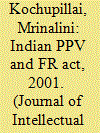

|
|
|
|
|
| Publication |
2011.
|
| Summary/Abstract |
This paper examines the objectives of the PPV&FR Act in the light of history and current state of Indian agriculture, drawing comparisons with approaches adopted by developed countries and/or the international community in the early days of plant variety protection where relevant. The analysis has been done with a view to determining the problems faced by Indian agriculture that the government seeks to resolve with the help of the PPV&FR Act. It provides a statistical analysis of plant variety application trends under the PPV&FR Act to determine whether the Act is 'effective' in the light of the objectives that it seeks to accomplish as per its statement of objects and reasons. Need and suggestions to make the Indian law more effective from a national interest perspective and also strengthening India's stand before the international community where Article 27.3(b) of the TRIPS Agreement continues to be under review are highlighted.
|
|
|
|
|
|
|
|
|
|
|
|
|
|
|
|
| 10 |
ID:
105123


|
|
|
|
|
| Publication |
2011.
|
| Summary/Abstract |
The United States offers several ways for plant breeders to protect their inventions; plant patents, utility patents, or plant variety protection. There are differences in the type of material that can be protected under each system and the criteria used to examine the application. There is often confusion among applicants regarding why the United States has so many choices, which choice or choices apply to their situation, how to file an application and how that application will be examined. This article provides a basic overview of plant patents, utility patents and plant variety protection in the US.
|
|
|
|
|
|
|
|
|
|
|
|
|
|
|
|
| 11 |
ID:
105131
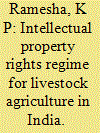

|
|
|
|
|
| Publication |
2011.
|
| Summary/Abstract |
In order to protect the interest of all stake holders of livestock farming in India, it is necessary to protect innovations in livestock sector through appropriate IP instruments along with conservation and sustainable use of native livestock breeds and associated traditional knowledge through sui generis system in the modern IPR regime. The unique attributes of indigenous livestock breeds could be exploited for profits by getting some form of intellectual property rights (IPR) or protection. An appropriate internationally accepted legal system with respect to use of livestock biodiversity and patenting of novel genes may bring about economic benefit to the livestock keepers in the IPR regime through benefit sharing. Harmonization of IP regimes, access to technologies required for biotechnological research and development through easy licensing and/or patent exemptions especially for public benefit oriented research would pave way for making private investments and private-public participation attractive. Present status of IPR protection in livestock sector in India and future prospects considering the typical livestock production situation existing in the country are analysed.
|
|
|
|
|
|
|
|
|
|
|
|
|
|
|
|
| 12 |
ID:
105127


|
|
|
|
|
| Publication |
2011.
|
| Summary/Abstract |
Private plant breeding has speeded up the introduction of new varieties and hybrids to improve productivity and production. Different intellectual property (IP) laws are in place to protect the innovation created in this sector. The relevant rights providing protection in this area include plant breeder's rights (PBRs) and patent rights. A peculiar exemption in plant breeding called 'breeder's exemption' in PBRs has been observed to play a vital role in innovation, an effect which was not seen as a result of the existing patent laws. The attention towards intellectual property rights in biological sciences and in particular, agricultural crops increased after TRIPS Agreement under WTO and each country enacted laws to protect the rights of innovators in crop breeding. Different forms of patent laws were already in place for protecting both processes and products in biological sciences in developed countries. But in most of the developing countries, these were available only for certain innovations. The complexity of biological systems and the available laws for protection of innovations are presently resulting in a lot of litigations among innovators in most of the countries. Broad patents granted in many crops for certain traits and also for essential breeding processes are resulting in apparent restriction of further research. A rational approach to protect innovation without restricting research has been put forth and discussed in this paper.
|
|
|
|
|
|
|
|
|
|
|
|
|
|
|
|
| 13 |
ID:
105129
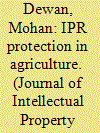

|
|
|
|
|
| Publication |
2011.
|
| Summary/Abstract |
Private rights in living objects have always been controversial. Agriculture provided the first wave in human civilization. Therefore, agriculture including plant breeding and agricultural methods pre-dated any form of IPR protection unlike industry and commerce. Traditionally, IPR was not applied to agriculture. In recent times, this position has changed and increasingly agriculture is seen as an industry that cannot survive without research and development and astute investments. This has made it necessary that IPR in all its forms be extended to agriculture.
|
|
|
|
|
|
|
|
|
|
|
|
|
|
|
|
| 14 |
ID:
105136


|
|
|
|
|
| Publication |
2011.
|
| Summary/Abstract |
One essential function of a technology transfer office is the proactive management of intellectual property related to crops and germplasm. Most of the agriculture stations and universities over the world have established technology transfer offices to protect their own plant varieties all over the world. This paper focuses on the patent policies, technology transfer policies and special practices within the office of technology commercialization at the University of California, which, by some measures, is the largest public technology transfer program in the world
|
|
|
|
|
|
|
|
|
|
|
|
|
|
|
|
| 15 |
ID:
105130


|
|
|
|
|
| Publication |
2011.
|
| Summary/Abstract |
Rapid developments of technological tools in the development of transgenic cotton harbouring the Bacillus thuringiensis (Bt) gene for conferring resistance to bollworm have played a major role in ushering an agri-biotechnology revolution at the global level and more so in Southeast Asian countries like India and China. The unprecedented increase in the use of these technologies and major investments by technology providers through strategic alliances or through agreements has brought the tools into a developing country like India. The objective of the present study is to assess patenting trends of this revolutionary technology in agriculture and its role in commercialization of the crop. Patent landscape analysis was deployed to map bibliographic patterns such as publication and priority year, country, assignees and technological analysis of major research areas with applications in technology development. The study illustrates the crowded domain of technology providers and the need to build strategic partnership platforms for effective use of the products.
|
|
|
|
|
|
|
|
|
|
|
|
|
|
|
|
| 16 |
ID:
105138


|
|
|
|
|
| Publication |
2011.
|
| Summary/Abstract |
A comprehensive Freedom to Operate (FTO) analysis requires analysing all forms of valid intellectual property (IP) rights and associated agreements and contracts to ensure that development or launch of any particular product/process in a particular market, in a particular country does not infringe any IP right of third party. FTO opinion is usually a legal advice; however, R&D organizations engaged in frequent patenting may also need to develop their in-house capability for FTO analysis. This paper illustrates methodology for FTO analysis, limited to patent rights.
|
|
|
|
|
|
|
|
|
|
|
|
|
|
|
|
| 17 |
ID:
105126
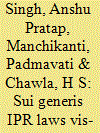

|
|
|
|
|
| Publication |
2011.
|
| Summary/Abstract |
The expansion of scope of intellectual property protection to include plant varieties and ensuing monopoly on genetic resources has raised concerns as it affects traditional rights of farmers. The International Treaty for Plant Genetic Resources for Food and Agriculture (ITPGRFA) provides an international recognition of farmers' rights. The International Union for the Protection of New Varieties of Plants (UPOV) is one of the most accepted sui generis system for the recognition of plant breeder's rights. The present study aims to analyse the farmers' rights development in South Asia from the perspective of intellectual property enforcement. Based on the membership to WTO, ITPGRFA and UPOV, the Asian countries were divided into four groups. It is observed that only Group B countries (which are members of ITPGRFA) have legislations with respect to farmers' rights. A comparison of the policy and legislation revealed that Nepal, Bangladesh, Pakistan and Philippines have framed the policy but legislations are yet awaited.
|
|
|
|
|
|
|
|
|
|
|
|
|
|
|
|
|
|
|
|
|